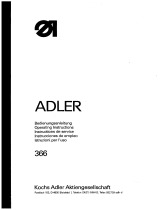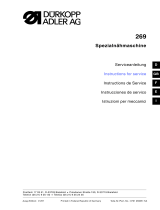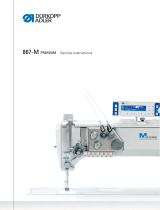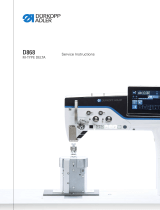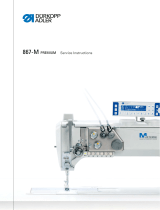Page is loading ...

510
CNC automat for bartacking seams
and short seams
Operating Instructions
Installation Instructions
Service Instructions
Postfach 17 03 51, D-33703 Bielefeld Potsdamer Straße 190, D-33719 Bielefeld
Telefon +49 (0) 5 21/ 59 25-00 Telefax+49(0)521/9252435 www.duerkopp-adler.com
1
2
3
Ausgabe / Edition: 02/2006 Printed in Federal Republic of Germany Teile-Nr.:/Part-No.: 0791 510001

Summary
Operating Instructions
Installation Instructions
Service Instructions
Interconnection-diagram
9890 510001 B

Foreword
This instruction manual is intended to help the user to become familiar
with the machine and take advantage of its application possibilities in
accordance with the recommendations.
The instruction manual contains important information on how to
operate the machine securely, properly and economically. Observation
of the instructions eliminates danger, reduces costs for repair and
down-times, and increases the reliability and life of the machine.
The instruction manual is intended to complement existing national
accident prevention and environment protection regulations.
The instruction manual must always be available at the
machine/sewing unit.
The instruction manual must be read and applied by any person that is
authorized to work on the machine/sewing unit. This means:
– Operation, including equipping, troubleshooting during the work
cycle, removing of fabric waste,
– Service (maintenance, inspection, repair and/or
– Transport.
The user also has to assure that only authorized personnel work on
the machine.
The user is obliged to check the machine at least once per shift for
apparent damages and to immediatly report any changes (including
the performance in service), which impair the safety.
The user company must ensure that the machine is only operated in
perfect working order.
Never remove or disable any safety devices.
If safety devices need to be removed for equipping, repairing or
maintaining, the safety devices must be
remounted directly after completion of the maintenance and repair
work.
Unauthorized modification of the machine rules out liability of the
manufacturer for damage resulting from this.
Observe all safety and danger recommendations on the machine/unit!
The yellow-and-black striped surfaces designate permanend danger
areas, eg danger of squashing, cutting, shearing or collision.
Besides the recommendations in this instruction manual also observe
the general safety and accident prevention regulations!

General safety instructions
The non-observance of the following safety instructions can cause
bodily injuries or damages to the machine.
1. The machine must only be commissioned in full knowledge of the
instruction book and operated by persons with appropriate
training.
2. Before putting into service also read the safety rules and
instructions of the motor supplier.
3. The machine must be used only for the purpose intended. Use of
the machine without the safety devices is not permitted. Observe
all the relevant safety regulations.
4. When gauge parts are exchanged (e.g. needle, presser foot,
needle plate, feed dog and bobbin) when threading, when the
workplace is left, and during service work, the machine must be
disconnected from the mains by switching off the master switch or
disconnecting the mains plug.
5. Daily servicing work must be carried out only by appropriately
trained persons.
6. Repairs, conversion and special maintenance work must only be
carried out by technicians or persons with appropriate training.
7. For service or repair work on pneumatic systems, disconnect the
machine from the compressed air supply system (max. 7-10 bar).
Before disconnecting, reduce the pressure of the maintenance
unit.
Exceptions to this are only adjustments and functions checks
made by appropriately trained technicians.
8. Work on the electrical equipment must be carried out only by
electricians or appropriately trained persons.
9. Work on parts and systems under electric current is not permitted,
except as specified in regulations DIN VDE 0105.
10. Conversion or changes to the machine must be authorized by us
and made only in adherence to all safety regulations.
11. For repairs, only replacement parts approved by us must be used.
12. Commissioning of the sewing head is prohibited until such time
as the entire sewing unit is found to comply with EC directives.
It is absolutely necessary to respect
the safety instructions marked by these signs.
Danger of bodily injuries !
Please note also the general safety instructions.

Index Page:
Part 3: Service Instructions Class 510
1. General notes ................................................ 3
2. Arm shaft
2.1 Preparatorywork............................................... 4
2.2 Assemblyofthecrank............................................ 5
2.3 Armshaftposition .............................................. 6
2.4 Bevel gear for the handwheel ....................................... 8
2.5 Adjust bobbin winder............................................. 9
2.6 Threadtrimmercam............................................. 10
2.7 Crankshaft drive to the hook shaft..................................... 11
2.8 Sewingmotorcoupling ........................................... 12
2.9 Referencepositionofthesewingmotor ................................. 13
2.9.1 Positionoftheinitiator............................................ 13
2.9.2 Adjustreferenceposition.......................................... 14
3. Hook, looping stroke and needle bar height
3.1 Drivershaft .................................................. 17
3.2 Gearsegmentonthecamshaft ...................................... 18
3.3 Gearsegmenttothedrivershaft...................................... 19
3.4 Needle bar height............................................... 20
3.5 Distance between hook tip and needle .................................. 21
3.6 Looping stroke and needle protection................................... 22
4. Thread-guiding parts
4.1 Threadcontrollerspring........................................... 23
4.2 Thread regulator ............................................... 25
4.3 Change thread wiper............................................. 26
4.3.1 General notes ................................................. 26
4.3.2 Remove/mount thread wiper ........................................ 27
4.3.3 Threadwiperheight............................................. 27
5. Thread trimmer
5.1 Thread trimmer magnet ........................................... 28
5.2 Position of the hook knife .......................................... 29
5.3 Cutting pressure / Position of the stationary knife ........................... 30
5.4 Thread guiding sheet ............................................ 32
5.5 Threadtrimmer................................................ 33
3

Index Page:
6. Material feed
6.1 Gauge for reference position ........................................ 34
6.2 Referenceposition.............................................. 35
6.3 Position of the fabric clamps and the rest plate to the needle .................... 37
6.4 Fabricclamplifting.............................................. 38
7. Oil lubrication
7.1 Oilcirculation................................................. 40
7.2 Lubricating oil pump ............................................. 41
8. Exchange the control unit ........................................ 42
9. Maintenance ................................................. 42

3
1. General notes
The service instructions on hand describe the adjustment of the
automatic bartacker 510.
ATTENTION !
The operations described in the service instructions may only be
carried out by qualified staff or other appropriately trained persons!
Caution: Danger of injury !
In case of repair, alteration and maintenance work switch off main
switch.
Carry out adjusting operations and functional tests of the running
machine only under observation of all safety measures and with
utmost caution.
These service instructions describe the adjustment of the automatic
bartacker in a logical order. Please observe in this connection that
various setting positions are interdependent. The adjustment process
must therefore be carried out int the order given.
For all setting operations of parts involved in the stitch formation a new
needle without any damage has to be inserted.
3

2. Arm shaft
2.1 Preparatory work
Some of the adjustments at the arm shaft 1 can be carried out easier if
the thread trimming mechanism 3 is removed before.
Caution: Danger of injury !
Switch off main switch.
Remove and mount thread trimming mechanism only when the
automatic bartacker is switched off.
Remove mechanism
–
Unscrew arm cover.
–
Loosen screw 4 at the thread trimmer magnet.
–
Unscrew screws 2 and 5 and take off thread trimming
mechanism 3.
Mount mechanism
–
Push thread trimming mechanism 3 on the magnet and place it on
the machine head.
–
Insert screws 2 and 5 and screw tight.
–
Tighten screw 4 at the thread trimmer magnet.
–
Adjust thread trimmer (see chapter 5).
4
5432
1

2.2 Assembly of the crank
Caution: Danger of injury !
Switch off main switch.
Remove and mount crank only when the automatic bartacker is
switched off.
Standard
The crank 4 has to be mounted on the arm shaft 1 in such a way that
the pivot 3 of the screw 2 reaches into the drill-hole on the arm shaft.
The screw 2 is the first screw in the direction of rotation.
Assembly
–
Push crank 4 on arm shaft 1.
–
Twist crank 4 in such a way that its first drill-hole in the direction of
rotation lies above the drill-hole in the arm shaft 1. Insert screw 2
with pivot 3 and screw tight.
–
Insert screw 5 and tighten.
5
3
41
4
2
3
5

2.3 Arm shaft position
Caution: Danger of injury !
Switch off main switch.
Check and adjust position of the arm shaft only when the automatic
bartacker is switched off.
Standard checking
The arm shaft 1 should have no axial backlash, but it must not move
too heavy.
–
Check the arm shaft with regard to axial backlash and rough
running.
Correction
–
Loosen screws at the thread trimmer cam 2.
–
Loosen screws at the adjusting ring 3 or tension release cam 8.
–
Loosen screws at the bevel gear 4.
–
Loosen screws at the bobbin winder wheel 5.
6
1
6 543 2
3
8

–
Loosen screw at the motor coupling 7.
–
Push arm shaft cam 6 axially to the right as far as it will go.
–
Push adjusting ring 3 to the left against the bearing bush and
tighten screws.
–
Check arm shaft with regard to axial backlash and smooth running.
–
Tighten screws at the thread trimmer cam 2
(adjustment see chapter 5).
–
Tighten screws at the bevel gear 4
(adjustment see chapter 2.2).
–
Tighten screws at the bobbin winder wheel
(adjustment see chapter 2.3).
–
Tighten screw at the motor coupling 7
(adjustment see chapter 2.6 ).
7
3
7
6 543 2
3
8

2.4 Bevel gear for the handwheel
Caution: Danger of injury!
Switch off main switch.
Check and adjust bevel gear only when the automatic bartacker is
switched off.
Standard checking
The bevel gear 1 has to be positioned on the upper shaft in such a way
that - when the handwheel 2 is engaged - there is as little clearance as
possible between bevel gear 1 and bevel gear 3.
–
Engage handwheel 2.
–
Check whether there is as little clearance as possible between
bevel gear 1 and bevel gear 3.
Correction
–
Loosen screws at bevel gear 1.
–
Engage handwheel 2.
–
Press bevel gear 1 against the toothed wheel 3 and tighten
fastening screws.
–
Turn handwheel and check whether there is as little clearance as
possible between bevel gear 1 and toothed wheel 3.
8
1
132

2.5 Adjust bobbin winder
Caution: Danger of injury!
Switch off main switch.
Check and adjust bobbin winder only when the automatic bartacker is
switched off.
Standard
The bobbin winding operation must stop automatically when the bobbin
is filled up to approx. 0.3 mm below the edge of the bobbin.
Correction of the bobbin winder wheel
–
Loosen screws at the driver wheel 1.
–
Shift driver wheel 1 axially in such a way that it abuts on the bobbin
winder wheel 2 with the bobbin cover screwed on .
–
Tighten screws at the driver wheel 1.
The second screw in the direction of rotation is located at a
spot-faced place.
–
Put on head cover and tighten.
–
Check bobbin winder and repeat adjustment, if necessary.
Correction of the bobbin capacity
–
Loosen screw 3.
–
Adjust bobbin winder clip 4.
–
Tighten screw 3.
Note:
When correcting the driver wheel take care that the oil wicks do not
collide with the driver wheel afterwards.
9
3
1
1
2
3
4
1

2.6 Thread trimmer cam
Caution: Danger of injury!
Switch off main switch.
Check and adjust thread trimmer cam only when the automatic
bartacker is switched off.
Standard checking
The correct position of the thread trimmer cam 1 is marked by a point
on the upper shaft 2 and a line on the thread trimmer cam 1.
The position is correct when both markings are standing opposite.
–
Engage handwheel and turn until the marking points 4 and 5 on the
upper shaft and the thread trimmer cam are visible.
–
Check whether both markings are standing exactly opposite.
Correction
–
Loosen screws 3 at the thread trimmer cam.
–
Twist and axially shift the thread trimmer cam in such a way that
both markings 4 and 5 are standing exactly opposite.
–
Tighten screws 3.
10
21
31
4
5
2
1

2.7 Crankshaft drive to the hook shaft
Caution: Danger of injury!
Switch off main switch.
Check and adjust crankshaft drive only when the automatic bartacker
is switched off.
Standard checking
The arm shaft and the hook shaft are connected by the connecting rod
4 gripping into the crank 1 of the upper shaft.
The connecting rod 4 and the upper bearing shell 2 have a marking on
one side. When assembling them the markings must be on the same
side.
Connecting rod 4 and bearing shell 2 must not jam when being
screwed together.
–
Check whether the markings are on the same side.
–
Tighten screws 3 equally.
11
3
1
32
4
2

2.8 Sewing motor coupling
Caution: Danger of injury!
Switch off main switch.
Check and adjust sewing motor coupling only when the automatic
bartacker is switched off.
Standard checking
Both coupling halves 1 and 2 must be positioned in such a way that the
knobs of the cam 4 abut on the left or on the right.
–
Rotate arm shaft with the handwheel and check whether the cam
has enough clearance in every position.
Correction
–
Loosen screw 3 at the coupling.
–
Adjust coupling piece 1 on the shaft axially.
–
Tighten screw 3 again.
–
Check clearance in the coupling.
12
1
2
4
3

2.9 Reference position of the sewing motor
2.9.1 Position of the initiator
Caution: Danger of injury!
Switch off main switch.
Check and adjust initiator only when the automatic bartacker is
switched off.
Standard checking
The distance between the initiator 1 and the largest outer diameter of
the 180° disc 3 should be as small as possible.
Correction of the distance between the 180° disc and the initiator
–
Loosen counternuts 4 and 5 at the initiator 1.
–
Set the smallest possible distance between initiator 1 and the
largest outer diameter of the 180° disc 3.
–
Tighten counternuts 4 and 5 at the initiator.
13
3
1
2
3
5
4

2.9.2 Adjust reference position
The adjustment of the correct reference position of the sewing motor is
done with the help of the adjusting aid in the control.
Call up adjusting aid
The adjusting aid shows the correct position of crank 1.
–
Switch on main switch.
The control is initialized.
The main menu appears.
–
Press function key “F” when the main menu is displayed.
–
Enter code number “25483”.
–
Press key “OK”.
After entry of the correct code number the display changes over to
the menu “Technician mode”.
machine config
user settings
service
free contours
memory dongle
14
1
Maschine
Freie Konturen
Memory-Dongle
Benutzer
Service

–
Select menu “Test functions”withkey “ò“.
–
Start menu with the key “OK”.
The menu for the test functions appears.
multitest
180°-disc
events
DAC III
init
–
Select menu “180° disc” with the keys “ñ“or“ò“.
–
Start menu with the key “OK”.
The following menu appears:
180°-disc
15
3
180° - Scheibe
1
Multitest
DAC III
INIT
180° - Scheibe
Ereignisse

Adjust 180° disc
–
Loosen screw 3 at the 180° disc 4.
–
Turn crank 1 by hand into the position indicated in the display.
–
Place the front side of the 180° disc centrally on the initiator 5 in
said position.
–
Tighten screw 3 at the 180° disc.
–
Press the “RST”key(BF2)orthe“OK” key (BF3).
If the adjustment is correct, the automatic bartacker positions
in such a way that the crank 1 is exactly behind the needle bar
bush 2.
The following menu appears:
180°-disc
–
Check whether the needle bar crank is in the position as indicated
in the menu.
–
Correct position of the 180° disc, if necessary. For this purpose
press “RST”key(BF2)orthe“OK” key (BF3), then correct
the 180° disc correspondingly.
–
Afterwards press “RST”key(BF2)orthe“OK” key (BF3) three
times in order to go to the altered reference position.
–
Check whether the crank 1 is in parallel position to the needle
bar bush 2.
–
If necessary, repeat the procedure.
16
54 3
21
180° - Scheibe
/





